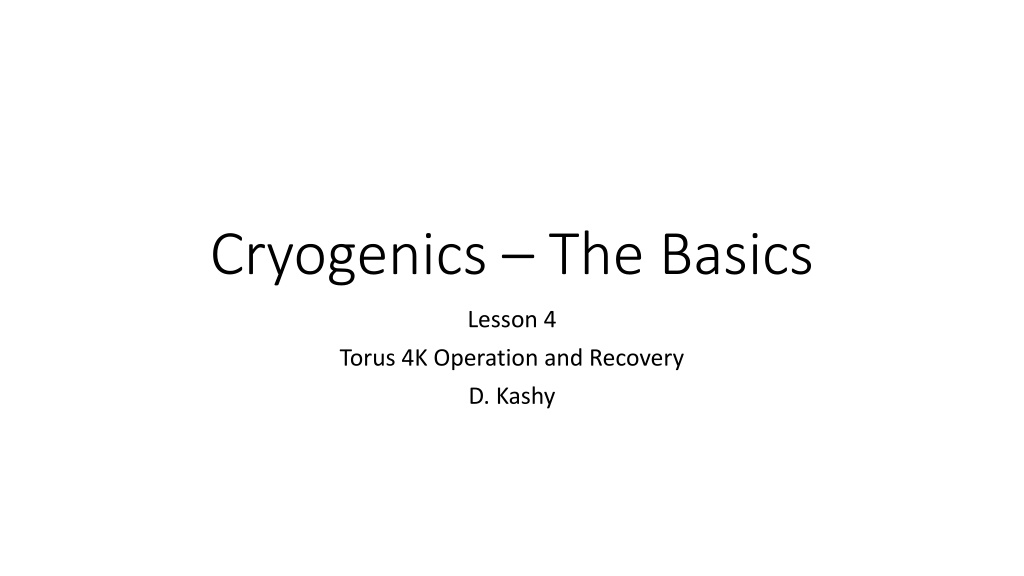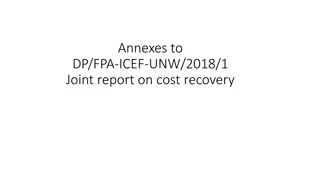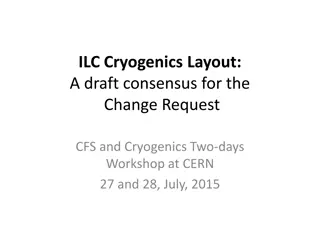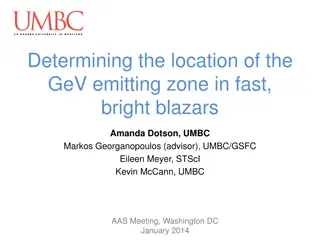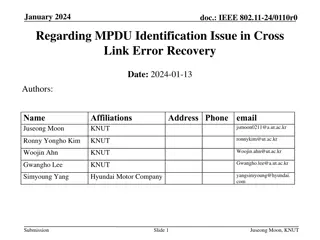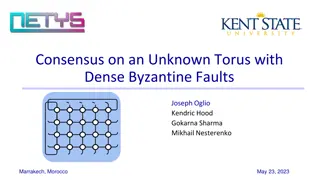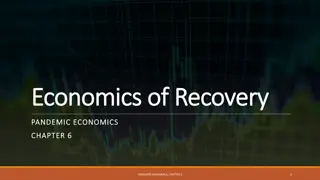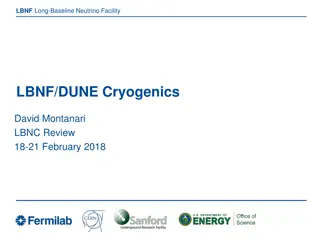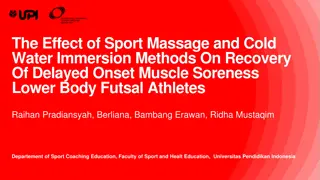Understanding Cryogenics: Torus 4K Operation and Recovery
This lesson delves into the intricate details of Torus 4K operation and recovery in cryogenics. Topics covered include supply from ESR main compressors, cold box, valve box, helium distribution, supercritical helium flow, back pressure control, and more. Special notes emphasize the importance of verifying PID control loop settings. Visual aids and explanations help operators navigate ESR compressors, cold box, valve box, and Hall B torus operation seamlessly. Key points and procedures are highlighted for efficient operation and troubleshooting.
Download Presentation

Please find below an Image/Link to download the presentation.
The content on the website is provided AS IS for your information and personal use only. It may not be sold, licensed, or shared on other websites without obtaining consent from the author. Download presentation by click this link. If you encounter any issues during the download, it is possible that the publisher has removed the file from their server.
E N D
Presentation Transcript
Cryogenics The Basics Lesson 4 Torus 4K Operation and Recovery D. Kashy
Lesson 4 - Topics Supply from ESR Main Compressors Cold Box Valve Box Hall B Distribution can for Helium Supply Torus flow paths and controls 4K Supercritical Gas Liquid Helium and Cold return Lead flow Back pressure control Return gas to ESR Off normal operation ESR shutdown Quench or Fast Dump of Torus What to look for if called in and what to do next Questions
Special NOTES The slides in this presentation are a snapshot in time. They give general principles of operation. The PID control loop settings may not be up to date so the operators must use the relevant spread sheets to verify recent and most proper settings. M:\hallb_eng\CLAS12\Magnets\Operations\Cryogenic Operations
ESR Compressors High Pressure Flow rate (g/s) The rest of the flow returns at the medium pressure Low Pressure Flow rate (g/s)
ESR Cold Box The rest of the flow returns at the medium pressure Super Critical Helium Flow to Valve Box Low Pressure Flow 4.5K return from Valve Box
ESR Valve Box (part 2) and 10,000 liter Dewar Helium Dewar With HX to cool the 4.5K supply CTD672 Warm return temperature from All 3 Halls (Important upon CD or Recovery) Small Polishing HX in the VB
ESR Valve Box (part 1) Nitrogen Sub-cooler to send 4atm liquid at 77K (subcooled liquid) 4K supply flow meter (note sometimes reads about double actual flow, normal is ~6-7g/s) 4K Return Line with Cold Return Valve CEV6721B (must be shut upon long ESR outages to facilitate Hall B magnet recovery
Hall B Distribution Box (DBX) Blue line is 4K supply, it feeds Torus, Solenoid and Buffer Dewar No Control PID s are presently being used on 4K supply in the DBX. All valves are in Manual mode
Main Control Screen DBX/ESR items Supply flow valves Coils and Recoolers Down Stream Hex Beam Temps Liquid Level Probes (DP and SC) Lead flow controllers Cool down Parameters Hall B Torus
Supply Controls EV8115JT Min is 40% to assure flow through Coils Max is 65% to keep from dropping the pressure below supercritical as shown on PT8115
Supply Controls EV8111CD
Return Controls The cold return valve (PV8522TR) is used to back pressure the helium reservoir to drive the lead flow The higher the pressure the warmer the coils
PLC Cryogenic Controls There are several PLC based controls that are programed and not user changeable Vapor Cooled Lead Flow Vapor Cooled Lead Flow Venting Reservoir Liquid Heater
PLC Control Lead flow The lead flow rate in standard liters per minute is shown on the main screen. The amount is programed to be 88slm at 0 Amps and 110slm (0.3g/s) each lead at full field, this flow returns to warm compressors (recovery or ESR 1st stage)
PLC Control Lead flow In the event that the lead flow stops due to high return pressure (PT8571 about the same as PT8120) then the PLC opens SV8122 and starts the magnet rampdown. This happens only if the magnet is powered! And it shuts after the magnet reaches 0 current.
Heater 8120 interlock This heater can not be turned on if the helium level is less than 20% on LL8120SC
Other controls Lead heaters There are two different sets of VCL heaters The ones displayed on the Torus Helium Screen are PLC controlled The second set is local controllers that have manual inputs and are on the vacuum rack on level 3
Additional screens/info for Torus Overview Coil Temperatures Relief Valve Temperatures Cool Down Parameters Interlocks
Coil Temps These buttons give details on each coil temperature. Most of these are on the Copper cooling sheets that surround the coil. One is on the coil case itself
Relief Valve Temps Relief Valve temperatures on all 4K circuit relief valves help to show if there is a relief valve that has not re-sealed and is leaking
Cool down Parameters This screen shows lots of parameters that are calculated and are used to assure safe cool down
Cool down Interlocks This screen shows interlocks for warm gas supply valves and heaters
Recovery after Cryo glitches or Fast Dumps We have set up the system to try to recover both the Torus and Solenoid as quickly as possible with goals of: Minimum intervention Often no intervention for short ESR outs Often no intervention for Solenoid Fast Dumps System protection Priority to Lead reservoirs so that magnets can stay on cold return If magnets need to go to warm return the conversion back to cold return can be managed by the cryogenics group in most cases reducing the likelihood of an ESR trip
Supply During Recovery Because both the EV8115JT and EV8111CD valves are programed to control Helium level LL8120SC they will both open to their Max allowed position to attempt to cool and refill the magnet. As long as the magnet is below 100K there is no limit to cooldown rate If the magnet is above 100K then an expert must be involved
Return During Recovery (empty reservoir and warmed coils >~7K) If the ESR goes down and both magnets warm up and all reservoirs empty then ESR must shut the cold return valve CEV6721B This will cause our magnet pressures to rise until our warm return valves PV8522TCD and SCD open because of their PID control loops Once the Torus reservoir and Solenoid Lead reservoir have >50% helium level cryo can slowly open their cold return valve our PID loops will automatically close our TCD and SCD valves If the Torus is the only load to warm up then the TCD valve may be opened and the TR valve closed, to allow solenoid and buffer dewar to remain on cold return. (This should be done by an expert operator)
What to look for if (when) called in Most likely the helium level (LL8120SC/DP for the Torus) will be low or empty The question is: Why? Look at the helium supply pressure and temperature in the DBX Look at the supply flow from the ESR Check our valves to see their status Check vacuum in the DBX and Torus Go to Hall B and walk around look for ice or sweat on U-tubes Contact Cryo to see status of ESR
TD8512 < 7K PT8512 > 2.7 atm If these are off there may be an ESR issue OR We could have warm gas returning from a magnet or the Buffer Dewar Check our systems further then contact Cyro ALSO TC8500DC < 5.0E-2 torr PT8563 < 2.0 atm Call Hall B cryo expert and or Hall B Vacuum expert Distribution Box - Normal
TD8111 < 6K PT8111 > 2.6 atm CFI6711B > 5g/s If these are off there may be an ESR issue OR We could have warm gas returning from a magnet or the Buffer Dewar ALSO PT8120 < 1.6 atm Contact Cryo to see if they are having an issue and look more into our system then contact Hall B cyro expert Torus Helium- Normal
Both Turbo pumps at ~100% Both Main and Secondary gate valves open Roots gate valve closed TC8103<9E-4 CG8103<9E-5 ESR down should NOT be lit (may need to be removed from this screen ) IF these conditions are not met call in both Torus and Vacuum Experts Torus Vacuum- Normal
